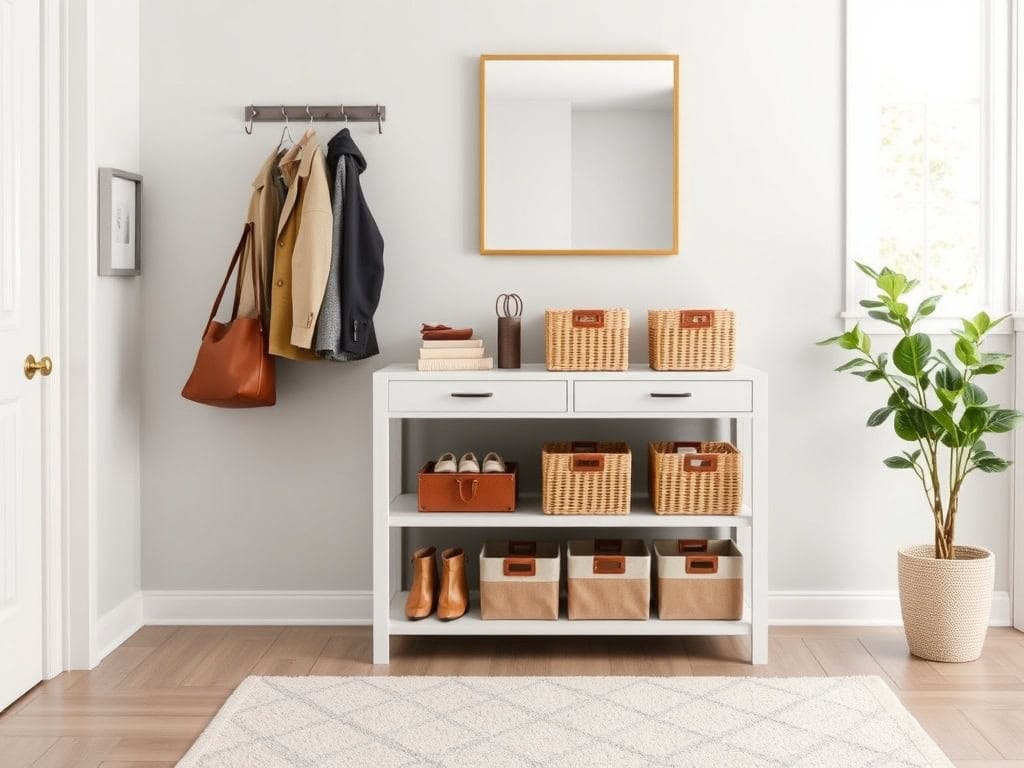Did you know that the average person spends nearly 10 minutes each morning searching for misplaced items near their entryway? That’s over 60 hours a year just hunting down keys, bags, and other essentials! As someone who transformed my chaotic entrance from a daily frustration into an organized oasis, I can’t wait to share these game-changing storage solutions. Whether you’re dealing with a tiny hallway or a spacious foyer, these eight practical tips will help you reclaim your mornings and create an entrance that actually works for your lifestyle.
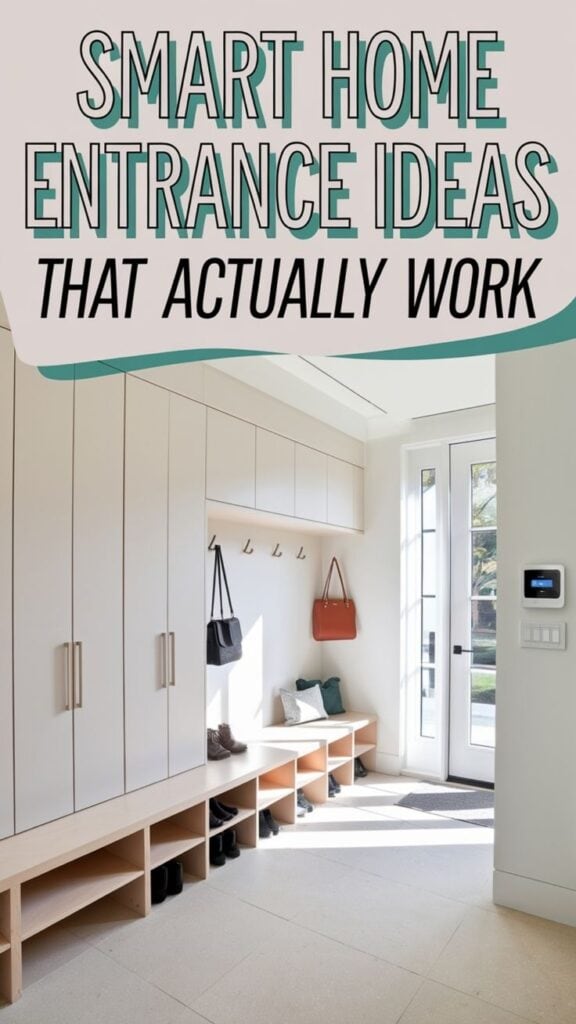
Install a Wall-Mounted Key and Mail Station
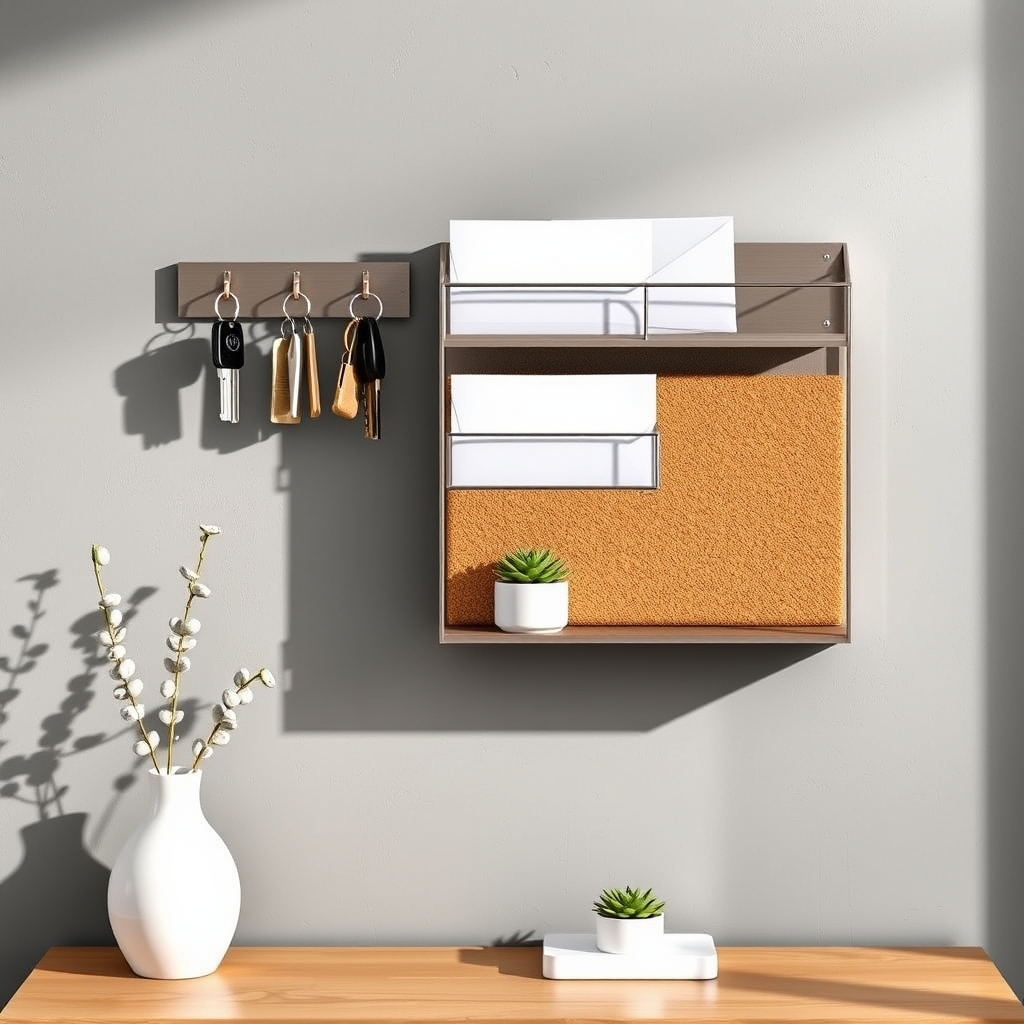
A well-organized key and mail station serves as the command center for your home’s daily operations. Without a designated space for these essential items, keys get misplaced, important mail gets lost, and valuable time is wasted searching for these everyday necessentials.
Installing a wall-mounted key and mail station transforms a chaotic entrance into an efficient hub for household organization. This system prevents items from cluttering horizontal surfaces and keeps important documents and keys readily accessible while maintaining a tidy appearance.
Required Items:
- Wall-mounted key and mail organizer
- Drill and drill bits
- Level
- Pencil
- Measuring tape
- Wall anchors
- Screwdriver
- Wall-mounting screws
- Key hooks
- Letter sorters or slots
- Labels or label maker
Select a location near your main entrance that’s easily accessible but not immediately visible from outside windows. Measure and mark the installation height, typically 5-6 feet from the floor. Using a level, mark screw locations and drill pilot holes. Install wall anchors if not mounting directly into studs.
Secure the organizer to the wall, ensuring it’s level and sturdy. Add key hooks and mail sorting components according to your household’s needs, creating designated spaces for incoming and outgoing mail, bills, and various sets of keys.
For optimal longevity and functionality, regularly clean the organizer and perform quarterly maintenance checks on mounting hardware. Consider implementing a color-coding system for different family members or key types, and establish a routine for processing mail immediately upon arrival.
Additionally, installing a small recycling bin nearby helps manage junk mail efficiently and maintains the organization system’s effectiveness.
Choose Multi-Purpose Bench Storage
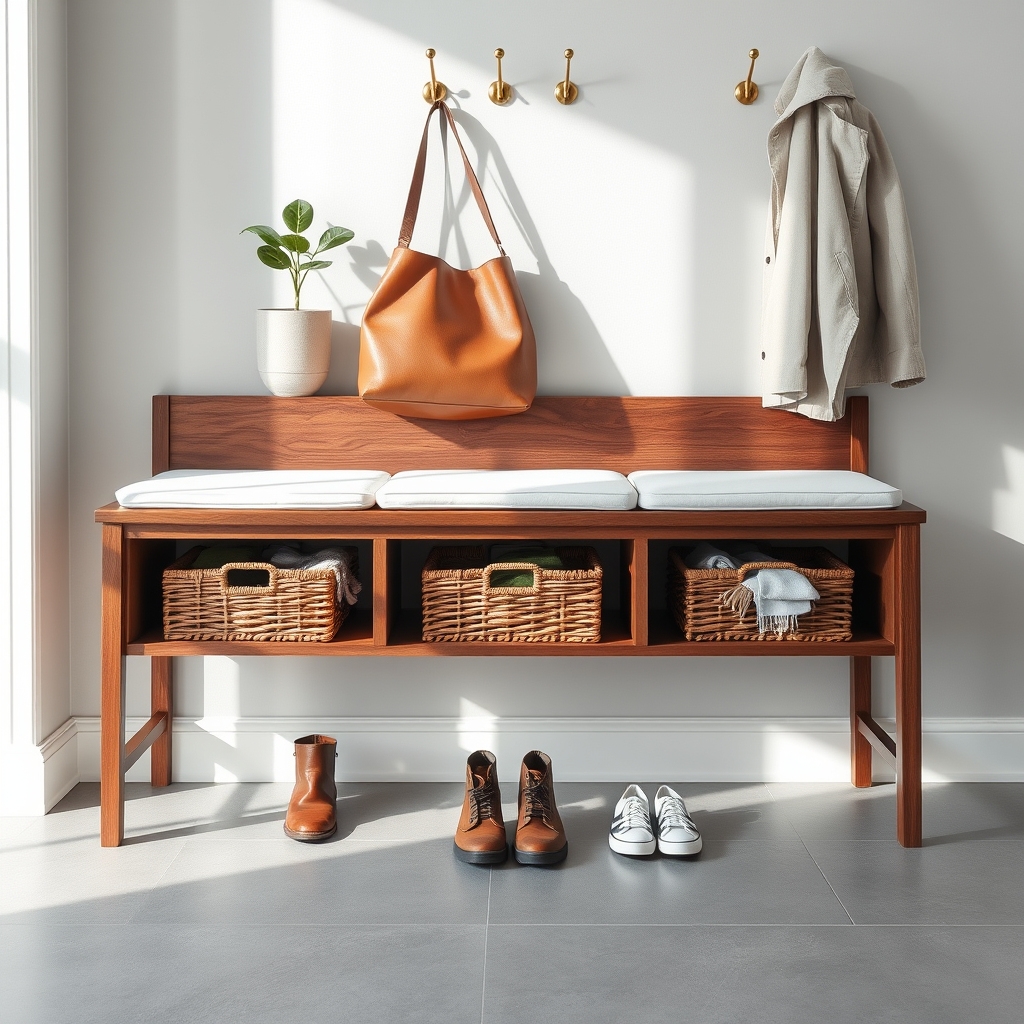
A well-organized entrance bench storage solution serves as the cornerstone of an efficient home entry system. This versatile piece of furniture not only provides a comfortable spot to remove shoes but also creates valuable storage space in what’s typically a high-traffic area of the home.
Multi-purpose bench storage transforms an often cluttered entryway into a functional space that accommodates daily essentials while maintaining a clean, welcoming appearance. By combining seating and storage, you maximize the use of limited space while creating a designated area for items that typically end up scattered throughout the home.
Required Items:
- Storage bench with compartments or drawers
- Storage bins or baskets
- Labels or label maker
- Shelf liner or drawer liner
- Drawer organizers or dividers
- Measuring tape
- Cleaning supplies
Select a storage bench that fits your space and needs, ensuring adequate height for comfortable seating and sufficient storage capacity. Measure the internal compartments and purchase appropriately sized bins or baskets to maximize organization. Line the storage areas with protective material to prevent wear and create a clean surface.
Divide the space into designated zones: one section for seasonal items like gloves and scarves, another for frequently used items such as shoes, and a third for emergency supplies or rarely used items. Position frequently accessed items in easily reachable compartments, while storing seasonal or occasional items in lower or harder-to-reach spaces.
Use drawer organizers or dividers to prevent items from mixing and maintain order. Label each section clearly to ensure family members maintain the organizational system.
To maintain the effectiveness of your bench storage system, implement a quarterly review and rotation schedule. Remove out-of-season items, clean the storage areas thoroughly, and reassess the organization system based on changing needs.
Consider installing hooks or a small shelf above the bench for additional storage options, and establish a “one in, one out” rule to prevent accumulation of unnecessary items.
Maximize Vertical Space With Hooks and Shelves
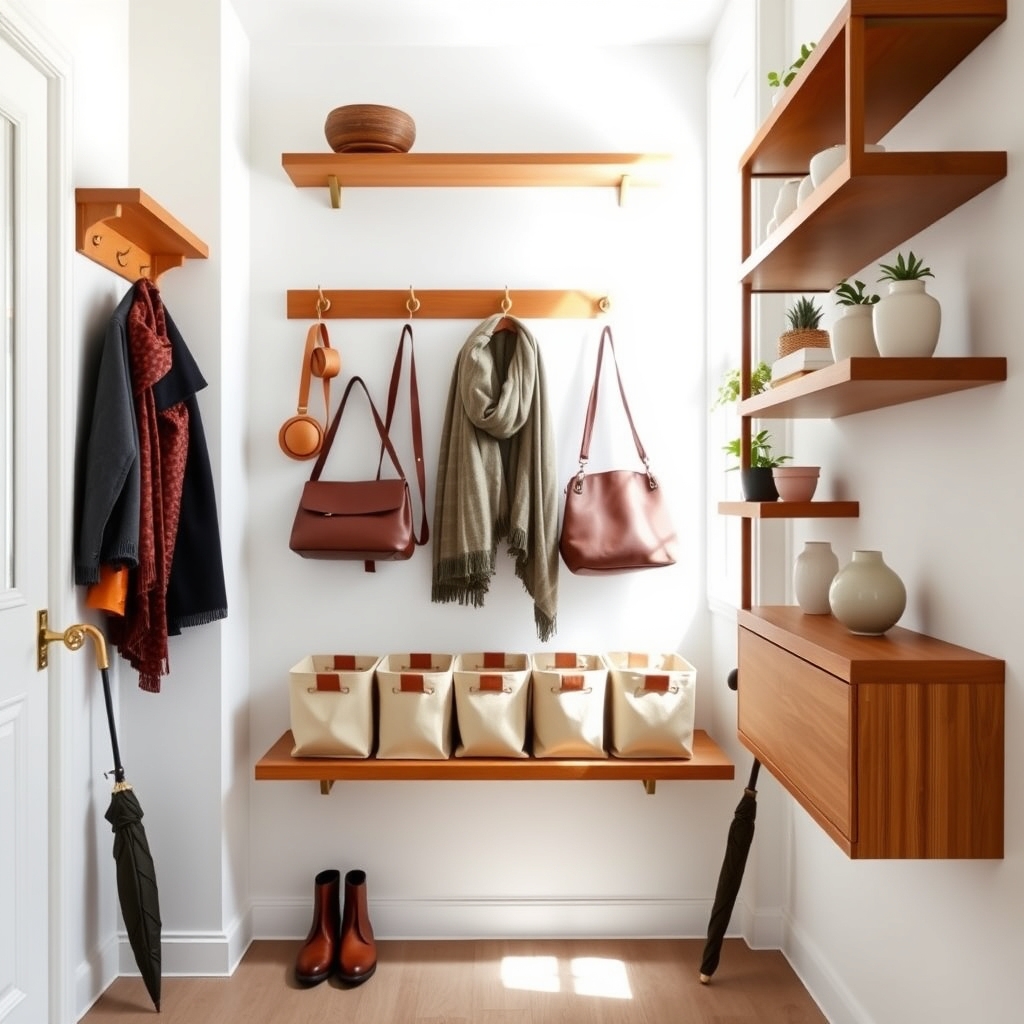
Making the most of vertical space in your home entrance is crucial for maintaining an organized and clutter-free environment. Wall-mounted storage solutions can transform a cramped entryway into a functional space that accommodates daily essentials while keeping the floor clear for foot traffic.
Proper vertical organization not only creates additional storage capacity but also establishes designated spots for items like coats, bags, and keys. This systematic approach reduces morning chaos and prevents the frustration of searching for misplaced items when heading out the door.
Required Items:
- Stud finder
- Level
- Drill and drill bits
- Screwdriver
- Wall anchors
- Mounting screws
- Wall-mounted hooks
- Floating shelves
- Measuring tape
- Pencil
- Storage baskets or bins
- Command strips (optional)
Start by using the stud finder to locate wall studs and mark their positions with a pencil. Measure and mark the desired heights for your hooks and shelves, ensuring frequently used items are easily accessible.
Install the highest shelves first, working your way down to maintain proper spacing. Secure hooks at varying heights to accommodate different items and family members. For areas without studs, use appropriate wall anchors to ensure stability.
When mounting shelves, consider creating zones: upper shelves for seasonal or less-frequently used items, middle shelves for everyday essentials, and lower shelves for children’s items or shoe storage. Install hooks between shelves to maximize space utilization, and consider adding small hooks specifically for keys and mail near the door.
Additional Tips: Consider installing a shelf with built-in hooks underneath for a streamlined look. Use clear labels on storage containers to maintain organization, and implement a regular cleaning schedule to prevent clutter accumulation.
When selecting storage solutions, choose weather-resistant materials for areas exposed to wet shoes or umbrellas, and ensure all mounted items can support the weight of your intended storage items.
Create Designated Zones for Family Members
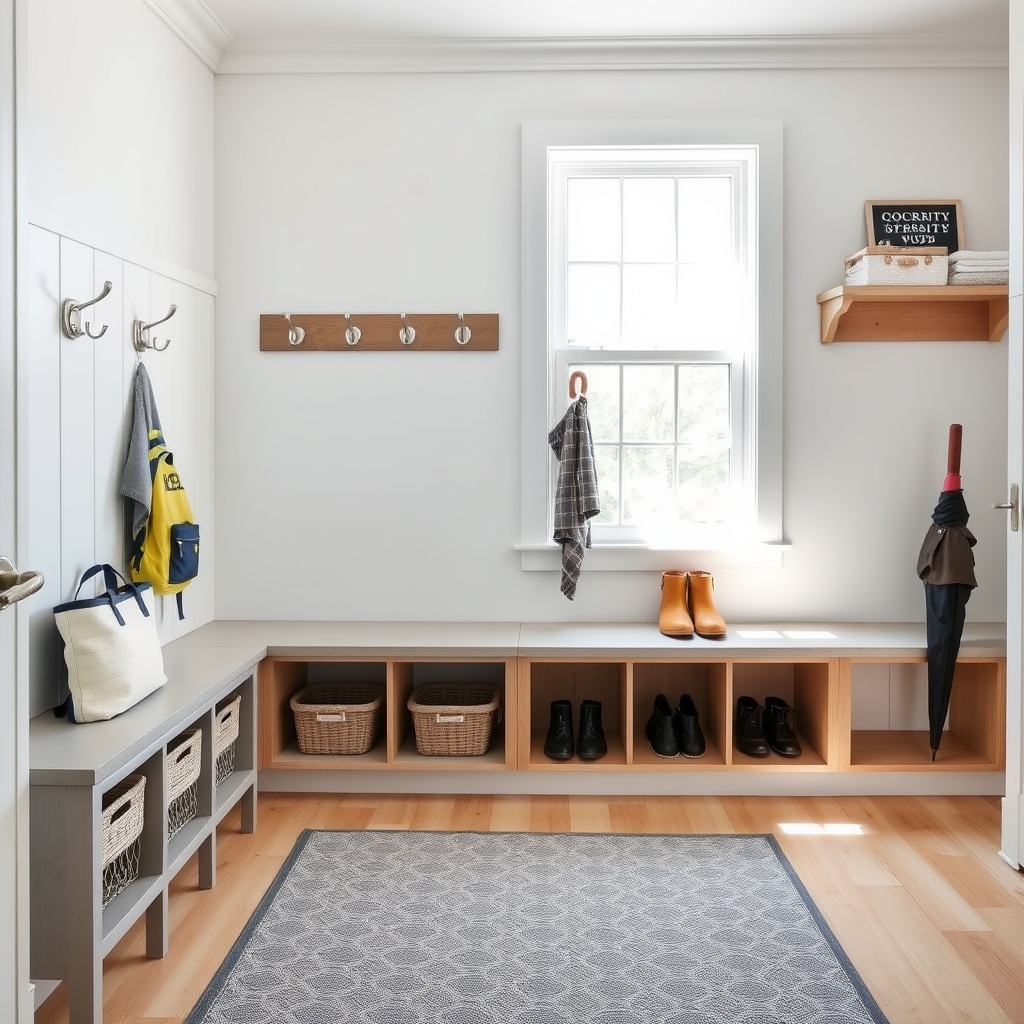
Organizing individual zones for family members at the home entrance prevents clutter buildup and eliminates the daily scramble to locate personal items. When each person has their dedicated space, it creates a sense of ownership and responsibility, making it more likely that items will be returned to their proper places.
A well-organized family entrance system reduces morning chaos and after-school confusion by providing clear boundaries and specific locations for everyday essentials. This systematic approach teaches children organizational skills while making the entire household run more smoothly.
Required Items:
- Labels or name tags
- Storage bins or baskets
- Wall hooks or pegs
- Shoe organizers
- Shelving units
- Storage bench (optional)
- Small storage containers
- Wall-mounted file holders
- Command hooks or mounting hardware
Start by measuring your entrance area and allocating equal spaces for each family member. Install hooks at appropriate heights, with lower positions for children to encourage independence. Below each hook section, place individual storage bins or baskets labeled with names for smaller items like gloves and scarves.
Add shoe storage solutions at floor level, ensuring each person has space for at least two pairs of frequently worn shoes. For additional organization, mount wall-mounted file holders or mail slots above each zone to manage paperwork, permission slips, and mail.
Consider incorporating small drawers or containers within each zone for personal items like keys, sunglasses, or charging cables. Color-code zones for younger children who can’t yet read labels.
To maintain the effectiveness of designated family zones, regularly assess and adjust the storage solutions based on changing seasonal needs and growing children. Implement a weekly cleanup routine where family members sort through their zones, removing unnecessary items and reorganizing their spaces.
Consider rotating seasonal items to maintain clutter-free zones and ensure the system remains functional year-round.
Implement a Seasonal Rotation System
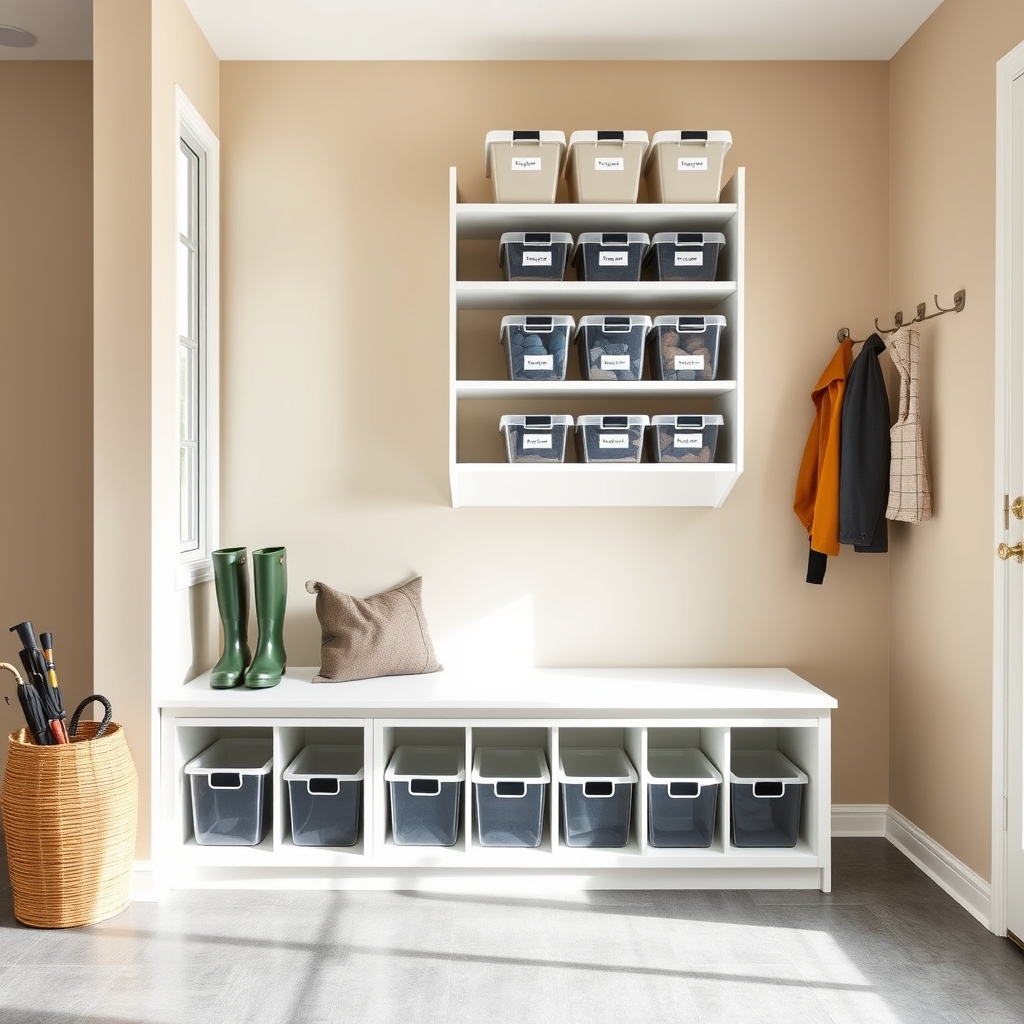
A well-organized seasonal rotation system for your home entrance is essential for maintaining an orderly and clutter-free space throughout the year. By implementing this system, you can ensure that only currently needed items are readily accessible while storing off-season gear efficiently.
The seasonal rotation system not only maximizes your entrance storage space but also streamlines daily routines by keeping relevant items within easy reach. This organized approach prevents overcrowding and makes transitioning between seasons smooth and stress-free.
Required Items:
- Large storage bins with lids
- Labels or label maker
- Storage bags (vacuum-sealed preferred)
- Plastic hangers
- Clear shoe boxes
- Storage bench or closet
- All-season storage rack
- Inventory checklist
- Cleaning supplies
The seasonal rotation process begins with a thorough assessment of your entrance items, separating them into distinct seasonal categories: spring, summer, fall, and winter.
Store current-season items at eye level or in easily accessible locations, while packing away off-season items in clearly labeled storage bins. Clean all items before storage, and use vacuum-sealed bags for bulky items like winter coats or beach towels.
Maintain a designated transition zone where you can gradually swap items as seasons change, typically allowing for a two-week overlap period.
Place frequently used items for the current season in prime locations – hooks at eye level, easily accessible shelves, or front-row storage.
Create zones within your entrance area: one for immediate-use items, another for transition-season items, and a third for long-term storage. Document the contents of each storage container in your inventory checklist to avoid unnecessary searching.
Success Tip: Review and update your rotation system monthly, adjusting for unexpected weather changes or special occasions.
Keep a small selection of all-season items accessible year-round, and maintain a “donate” box for items that haven’t been used in the past year. This regular maintenance ensures your seasonal rotation system remains effective and adapts to your changing needs.
Add Built-in Cabinets or Floating Units
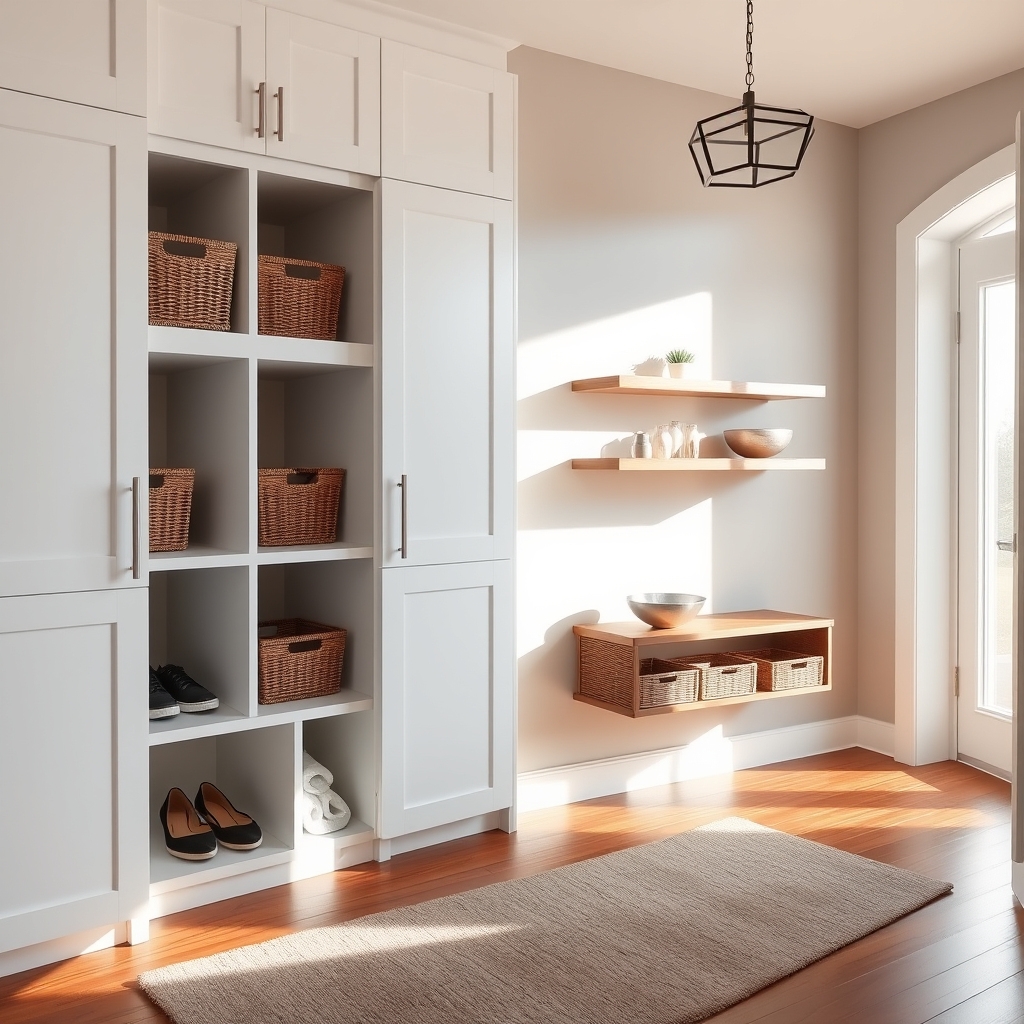
Built-in cabinets and floating units transform an ordinary entryway into a highly functional space that sets the tone for your entire home. These storage solutions help eliminate clutter while providing designated spaces for everyday items, making your daily routine smoother and more efficient.
Proper cabinet and floating unit organization maximizes available space while maintaining an aesthetically pleasing entrance. When thoughtfully arranged, these storage solutions can accommodate everything from shoes and outerwear to keys and mail, ensuring essential items are always within reach while keeping your entryway pristine.
Required Items:
- Measuring tape
- Level
- Pencil
- Storage containers or baskets
- Drawer organizers
- Labels
- Shelf liner
- Cabinet hardware
- Mounting brackets
- Wall anchors
- Screwdriver
- Drill
Start by measuring your cabinet or floating unit spaces and creating designated zones for different categories of items. Install drawer organizers and shelf liners to protect surfaces and prevent items from sliding. Position frequently used items at eye level, with seasonal or less-used items stored in higher or lower spaces.
Add hooks inside cabinet doors for additional vertical storage, and utilize clear containers or baskets to group similar items together. For floating units, ensure proper installation using wall anchors and mounting brackets rated for the expected weight load. Arrange items by frequency of use and maintain clear sight lines to preserve the open feel of your entryway.
Consider incorporating a combination of open and closed storage to balance aesthetics with functionality.
Additional Tips: Regularly assess and adjust your organization system based on changing needs and seasons. Install motion-sensor lighting inside cabinets for better visibility, and maintain a rotation schedule for seasonal items.
Consider adding a small tray or dish for frequently accessed items like keys or sunglasses, and implement a regular cleaning schedule to prevent dust accumulation in less-frequently accessed areas.
Set Up a Shoe Storage Solution
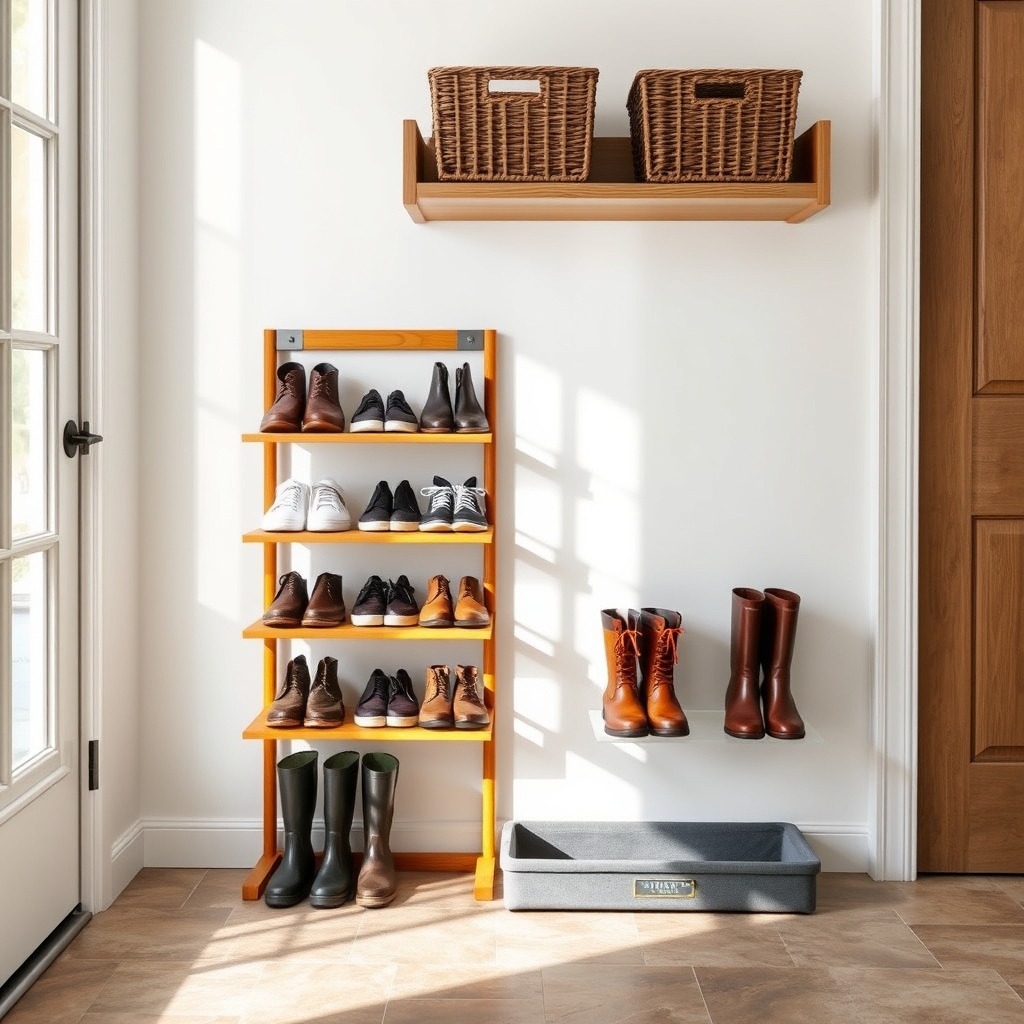
A well-organized shoe storage system at your home’s entrance is crucial for maintaining order and cleanliness in your living space. Without proper organization, shoes can quickly accumulate, creating clutter and making it difficult to locate specific pairs when needed, while also tracking dirt throughout your home.
An effective shoe storage solution not only keeps footwear organized but also maximizes available space and creates a welcoming entrance. When shoes are properly stored, they maintain their shape and condition longer, protecting your investment while contributing to a more organized and stress-free home environment.
Required Items:
- Shoe rack or shelving unit
- Storage bench (optional)
- Over-door shoe organizer (optional)
- Boot trays
- Storage bins or baskets
- Labels
- Measuring tape
- Cleaning supplies
Start by measuring your designated shoe storage area and selecting an appropriate storage solution that fits the space. Position a waterproof boot tray near the entrance for wet or muddy shoes.
Install your chosen storage system, whether it’s a traditional shoe rack, built-in shelving, or a combination of solutions. Group shoes by family member or type (casual, formal, seasonal) to create an intuitive organization system. Ensure frequently worn shoes are easily accessible at eye level, while seasonal or special occasion footwear can be stored in less accessible spaces.
For optimal maintenance and longevity of your shoe storage system, establish a regular cleaning schedule and clear guidelines for family members. Rotate seasonal shoes to storage when not in use, and consider using enclosed storage solutions for special occasion footwear to protect them from dust.
Implement a “one in, one out” rule to prevent overflow, and periodically assess your collection to donate or dispose of worn-out shoes.
Incorporate Hidden Storage Furniture
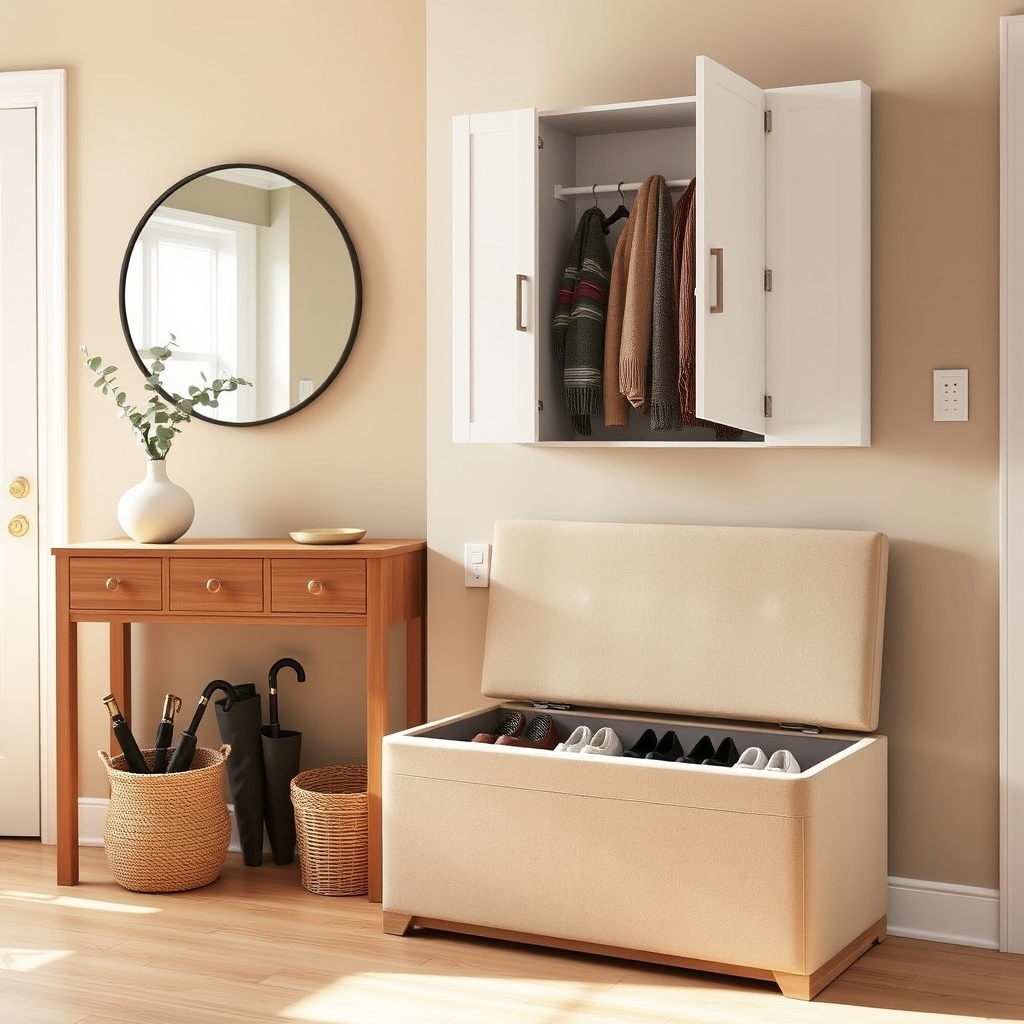
A well-organized entryway sets the tone for the entire home while managing the daily flow of belongings that come and go. Hidden storage furniture serves as a crucial solution for maintaining a clutter-free entrance while maximizing available space in what’s typically a high-traffic area.
Hidden storage furniture combines functionality with aesthetics, allowing homeowners to maintain a sleek, welcoming entrance without sacrificing storage capacity. These dual-purpose pieces help contain everyday items like shoes, bags, and seasonal accessories while presenting a clean, organized appearance to guests.
Required Items:
- Storage bench or ottoman
- Console table with drawers
- Wall-mounted cabinet
- Storage baskets or bins
- Labeled dividers
- Measuring tape
- Level
- Basic tools for assembly
- Furniture anchors
- Storage hooks
Select furniture pieces that match both your storage needs and available space. Position a storage bench against the wall, ensuring it’s anchored securely if necessary. Install a console table with hidden compartments nearby, utilizing the drawers for smaller items like keys and mail.
Maximize vertical space by mounting a decorative cabinet that conceals everyday clutter. Create designated zones within each piece: shoes in the bench, seasonal items in the cabinet, and daily essentials in the console drawers.
If space permits, layer your storage solutions by placing smaller organizational tools like baskets or bins inside larger furniture pieces. Install hooks on the interior of cabinet doors for additional hanging storage, and use drawer dividers to separate items within console compartments.
Consider furniture pieces with lift-top storage, which provides easy access while maintaining a clean appearance. For optimal functionality, rotate stored items seasonally and establish a system where frequently used items are most accessible.
Consider furniture pieces with water-resistant materials for wet shoes and umbrellas, and implement a weekly maintenance routine to prevent hidden storage areas from becoming disorganized catch-alls.

